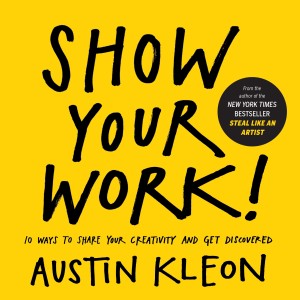Note: This was originally posted on Design Sprints.
I don’t read particularly quickly, but I finished Austin Kleon’s Show Your Work in a single sitting. It’s great for identifying what work is worth sharing and getting inspired to share it more frequently.
Here are the book’s ten main points and how they apply to me, design, development, prototyping, and my plans for this site.
You don’t have to be a genius
This is very good for me.
Think process, not product
I’m glad I really enjoy prototyping. It’s part of the process and leads to a better end result. On the other hand, it’s important to remember it isn’t the end in itself.
The idea of focusing on the process falls in line with other things I’ve read about work and learning. It becomes a cycle. When you learn to enjoy the process, you’ll improve and as you improve you’ll enjoy the process more. This gets you past dips and leads to better end products.
I forget where I heard this, but someone pointed out that people overestimate what they can finish in a day and underestimate what they can get done in months or a year. This can make it hard to start something big because you don’t think you’ll be able to finish it. But if you show up every day it adds up.
Share something small every day
After a few years of having a Dribbble account, I finally posted one thing. But I’ll start sharing more there. For all the flak it gets about comments being “Good job!” well, is that so bad?
It’s probably not the best place if you’re looking for serious critiques to improve things. But a design community with positivity as its core is, well, a net positive.
Open up your cabinet of curiosities
I’ve been linking to things on this site but I’m thinking of changing the format for sharing links. The ongoing link blog is sort of dead. Long live the newsletter.
Tell good stories
Austin Kleon talks about how art sometimes isn’t immediately interesting until you learn the story behind it. But something seemingly mundane with a good story is interesting because the story is interesting.
In that sense, I can look at the design sprint posts as stories explaining how certain prototypes came to be. I love reading other design process posts. Here are a few that come to mind:
I can’t get enough of these. They’re good stories.
Teach what you know
I try sharing what I know about Framer, Origami, and Form. Even with varying skill levels with each tool.
I’ve listened to Ben Orenstein’s Giant Robots podcast for a few months now. Learning and teaching come up as topics regularly in episodes. He encourages blogging every day:
Write about what you’ve learned so far. Don’t make the excuse that you’re just a beginner. Imagine someone who is two months behind you and write for them.
Recent beginners can be better at helping a novice because they just went through the same issues. Experts can lose that perspective. A huge benefit of it is that it really solidifies your own knowledge. Through teaching, you organize your own knowledge and identify the gaps that can be improved.
I’ll continue writing and putting videos together as I learn.
Don’t turn into human spam
My greatest fear. I was an over-sharer through high school and college. Then pulled it back in the past few years. And now I’m slowly ramping it up. The best way to avoid turning into human spam is to create interesting things. If spammers sent out a bunch of stuff people loved and found value in, well, it wouldn’t be spam.
Learn to take a punch
I wrote a Material Design post last year and was pretty excited that people were reading it.
Then one person tweeted it was “boring as hell”. It’s fine, I was ready for that jab. But then some designers I really respect favorited the tweet. So it was like the jab was chained into an E.Honda special.
This reminds me of one of Pasquale D’Silva’s tweets: “A glitch in many designers is the lack of ability to detach emotion from criticism.” It’s been really helpful to remember that criticism is free feedback.
Sell out
I’d love to. I’m putting affiliate links in book note posts and that’s about it so far. I read a lot of books and won’t be writing notes for all of them. It’d be great if it could pay for a better microphone or something of that sort.
In the meantime, I’ll stay focused on creating useful content.
Stick around
The first thing I wrote about design that anyone really read was about a personal design sprint. I’ve written a long piece about once every month or two since then. I want to keep it up. But I also want to start writing shorter things. Which is why I started designsprints.com.
I’ll stick around.
